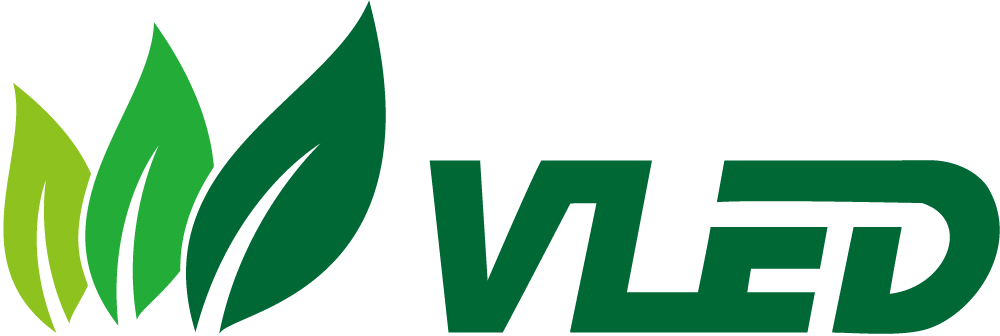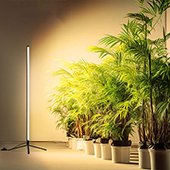Menu
How to Grow Tomatoes Indoors with Lights?
We all know that land resources are precious nowadays, and planting tomatoes in a greenhouse is like “compressing” a piece of farmland into a glass house, saving a significant amount of land.
Greenhouses can also utilize multi-layer vertical cultivation, stacking one layer upon another to expand upward, allowing for the cultivation of a large area of tomatoes even in places where land is scarce.
The year-round continuous production feature is truly impressive. Regardless of whether it’s icy cold or scorching hot outside, the greenhouse can create a stable growing environment, allowing tomato plants to thrive without being affected by seasonal changes.
The credit must be given to LED grow lights. Even though sunlight can penetrate through the transparent roof of the greenhouse, during overcast days or in winter when sunlight is insufficient, LED grow lights become the artificial sun for tomatoes.
These LED greenhouse lighting emit the red and blue light spectrum that tomatoes love, providing them with a nutritious feast, and ensuring their healthy growth, flowering, and fruiting.
Table of Contents
Selection and Setup of LED Grow Lights in Greenhouses
- Spectrum Requirements and Light Intensity
According to research, the ideal red-to-blue light ratio for tomato growth typically ranges from 2.5:1 to 4:1. This ratio can be fine-tuned based on the tomato variety and growth stage.
Regarding light intensity, the total light intensity should be approximately 5000-7000 lux for the entire day. When growing indoors, you can refer to this value to ensure that plants receive at least 12-16 hours of effective light exposure each day, simulating a natural light environment.
- Layout
LED grow lights should be arranged with a certain spacing to ensure uniform light distribution to the plant canopy. For instance, if your greenhouse is wide, you can opt for a staggered or checkerboard layout to ensure there are no dark spots.
The specific spacing can be determined based on the light intensity and coverage range of the fixtures themselves. As a general recommendation, the distance between adjacent fixtures should not exceed 1 meter to ensure continuous light coverage.
- Height Adjustment
For tomato plants, the ideal height of LED grow lights from the top of the plants should be adjusted according to the plant’s growth stage.
Generally, during the seedling stage of tomatoes, a distance of about 20-30 centimeters between the light fixture and the top of the plants is appropriate. This ensures that the lower light requirements of seedlings are met without causing a light burn.
As the plants grow, the height of the light fixture should gradually increase. During the vigorous growth and fruiting stages, the distance between the light fixture and the top of the plants is typically adjusted to be between 40-60 centimeters.
This adjustment is necessary because the plants increase in size, requiring a larger area of light coverage, while also preventing the light source from being too close and affecting the color and quality of the fruits.
LED Grow Lights for Tomato Seed Germination and Seedling Development
Using LED plant lights for tomato seed germination and seedling stage culture is a delicate task.
Germination Stage
Selecting LED Grow Lights: It’s recommended to choose LED grow lights with a broad spectrum of specifically tailored red and blue spectra for the germination and seedling stages.
LED panel grow lights or LED tube grow lights are suitable options as they can provide red light (620-660nm) and blue light (420-460nm), both of which are crucial for plant germination and early seedling growth.
Germination Setup:
Light Intensity: During the germination stage, seeds do not require intense light exposure. It’s recommended to maintain light intensity at around 100-200 lux to avoid suppressing seedling growth. As seedlings emerge from the soil, gradually increase the light intensity to 300-500 lux.
Lighting Duration: Maintain a lighting duration of 12-16 hours per day during the germination stage. Provide darkness for the remaining hours, as this helps seeds germinate normally and establishes a proper day-night rhythm for the seedlings.
Nurturing During Seedling Stage
Selection and Adjustment of LED Lights: As the seedlings grow, it’s essential to adapt the type and settings of the LED lights to meet the increasing light requirements during the seedling stage.
Opt for LED grow lights with higher brightness and a balanced spectrum, including lights with a higher proportion of red and blue light. Additionally, supplement with a moderate amount of white light (such as 6500K) to support healthy leaf development.
Light Intensity and Height:
Once the seedlings have developed true leaves, the light intensity can be increased to 1000-2000 lux. Adjust the duration of light exposure to 16-20 hours per day based on the specific requirements of the seedlings.
The distance between the LED lights and the seedlings should gradually increase as the seedlings grow. During the seedling stage, maintain a distance of 20-30cm to prevent heat damage to the tender leaves.
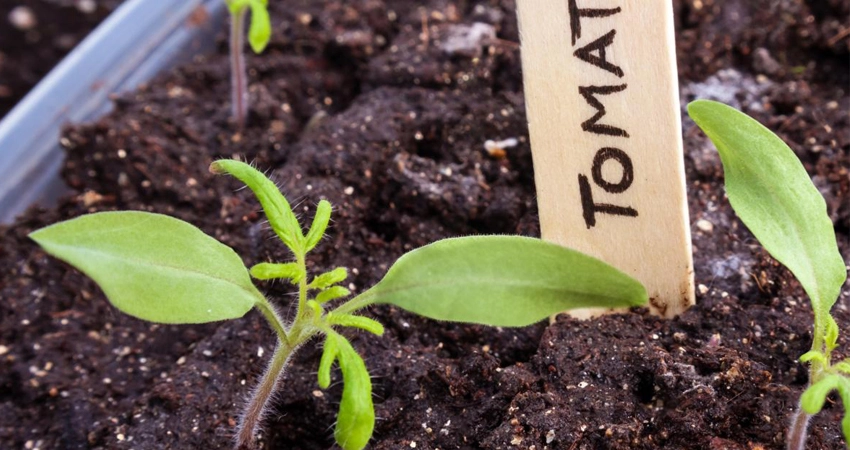
Transplanting Techniques for Seedlings at a Certain Stage of Growth
Transplanting tomato seedlings in a greenhouse environment involves considerations beyond just planting density and soil quality; factors like light, temperature, humidity, and the professionalism of facilities and equipment are crucial.
When seedlings reach a certain stage of growth, they need to be transplanted into larger growing spaces to allow for further root expansion and overall better plant development.
1. Determine Transplanting Time
Transplanting tomato seedlings is best done when they have grown 2-4 true leaves, and their root systems are healthy and no longer crowded. At this stage, the seedlings have good resilience and regenerative capacity, allowing for quick recovery after transplantation.
2. Prepare Transplanting Beds or Pots
For greenhouse transplanting beds, ensure they are leveled beforehand to facilitate proper drainage. Fill them with a substrate rich in organic matter, well-structured, and with good water retention and fertility capabilities. Maintain a pH level between 6.0 and 6.8.
If using pots, choose appropriately sized plastic pots or clay pots with drainage holes at the bottom to prevent water accumulation and oxygen deficiency in the roots.
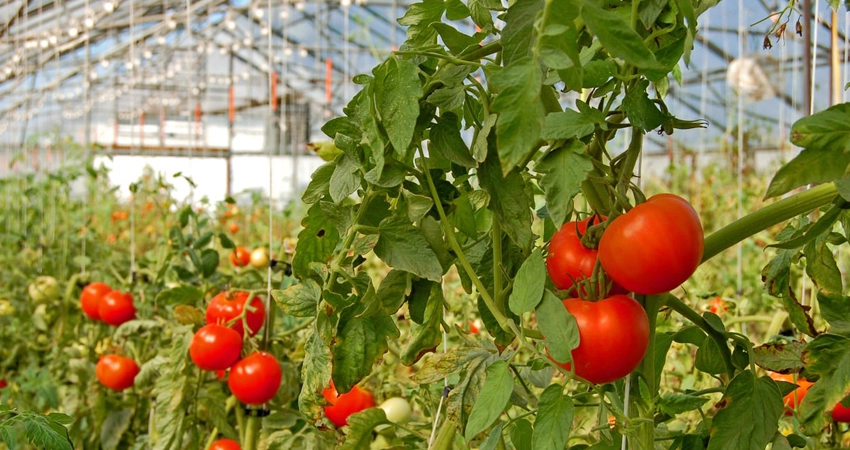
3. Plant Spacing
In greenhouse tomato cultivation, plant spacing is typically maintained between 40-60 centimeters, with row spacing ranging from 60-100 centimeters.
These distances can be adjusted based on the greenhouse’s ventilation and light transmission conditions, as well as the characteristics of the tomato variety chosen, to ensure that plants do not interfere with each other’s photosynthesis and air circulation.
4. Transplanting Method
When lifting seedlings, try to keep the root ball intact to minimize root damage. If using soilless seedling trays, also take care to protect the roots.
During transplanting, place the seedlings into pre-dug holes with the root collar level with the soil surface. Fill the surrounding area with soil and gently press to ensure good root-soil contact.
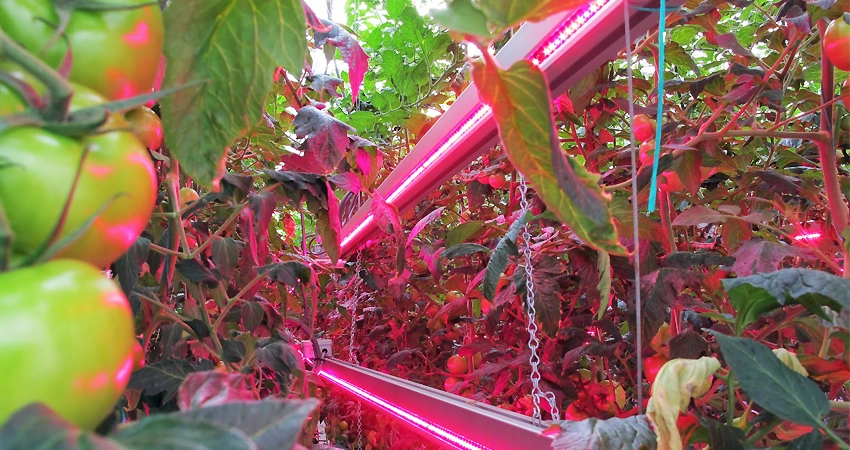
5. Water Management
After transplanting, immediately water the plants to establish root systems, ensuring thorough integration between roots and soil. However, avoid overwatering, as it can lead to oxygen deficiency in the roots or the occurrence of diseases.
6. Light and Temperature Control
Adjust the height and intensity of the greenhouse LED grow lights according to their design. It’s recommended to maintain a distance of 40-60 centimeters from the top of the plants, with light intensity around 5000-7000 lux, to simulate natural lighting conditions.
Maintain greenhouse temperatures between 25-30°C during the day and 15-20°C at night to ensure an optimal growing environment for the transplanted seedlings.
7. Post-Transplant Management
In the days following transplantation, provide some shade to reduce water evaporation and help the seedlings acclimate to their new environment.
Monitor the growth status of the seedlings closely. If there are signs of wilting or pest infestation, adjust environmental conditions promptly or implement appropriate pest control measures.
Adjusting LED Grow Light Scheme After Transplantation
After transplanting the seedlings, the LED grow light scheme also needs adjustment. At this stage, you can consider increasing the number of light fixtures or extending the duration of light exposure to ensure that each tomato plant receives sufficient sunlight.
Additionally, it’s essential to adjust the height of the light fixtures as the plants grow taller. This ensures uniform light distribution across the foliage, enabling comprehensive and healthy growth of the tomato plants.
Light Intensity and Duration Adjustment
- Light Intensity:
After transplanting, tomato plants require stronger light stimulation to promote growth and flowering. In the greenhouse, the recommended light intensity is approximately 7000-10000 lux.
Adjust the distance between the light fixtures and the plants based on the actual output capacity of the fixtures and the plant’s light requirements, typically between 40-60 centimeters.
Furthermore, to simulate natural sunlight, a dynamic lighting system can be employed, with lower light intensity in the morning and evening, and higher intensity around midday.
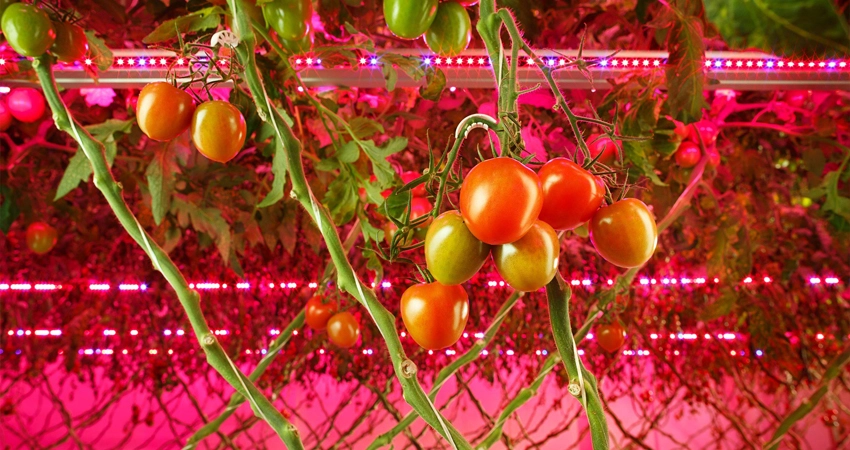
- Spectral Adjustment:
Growth Stage: During the growth stage, plants primarily require red light (620-660nm) and blue light (420-460nm) to promote leaf growth and stem strength. Additionally, a moderate amount of far-red light (720-730nm) aids in plant elongation and enhances stress resistance.
Flowering and Fruiting Stage: Increase the proportion of red light (such as adjusting the ratio of red light to blue light to 8:1 or 10:1) to promote flower bud differentiation and fruit development.
- Light Duration:
After transplanting, tomatoes should receive 14-16 hours of light exposure per day, which can be adjusted based on specific seasons and geographical locations to mimic natural daylight cycles as closely as possible.
Automated control systems or plant light controllers can be used to regulate the working time of LED grow lights, ensuring that plants receive adequate and consistent light exposure.
Layout and Uniformity
- Layout:
To avoid the formation of light hotspots or dark areas, a multi-layer hanging or cross layout can be adopted. Our greenhouse LED toplighting GB17 and LED interlighting GB18 complement each other as a greenhouse lighting system, ensuring that each plant receives uniform light exposure.
- Uniformity Testing:
Regularly use a spectroradiometer to measure the uniformity of light intensity in the greenhouse, ensuring that the difference in light intensity between different areas is controlled within ±10%.
Dynamic Lighting Strategy
- Adjusting Based on Plant Growth Stage:
As plants grow, adjust the position of the lights according to the thickness and height of their canopy, maintaining an appropriate distance between the light source and the leaves to ensure light penetration to the lower and middle parts of the plant.
- Integrating Environmental Factors:
Incorporate environmental factors such as natural light exposure, temperature, and humidity inside the greenhouse to dynamically adjust the LED plant lighting scheme. For example, extend artificial lighting time appropriately during overcast days or when natural sunlight is insufficient in winter.
Disease and Pest Control
Common Diseases
Powdery mildew, gray mold, late blight, and others are common diseases affecting greenhouse tomatoes. While the lighting environment aids in disease control, regular application of protective fungicides is still necessary.
Early identification and treatment of diseases are crucial. Upon detecting symptoms, biological pesticides or low-toxicity, high-efficiency chemical agents can be sprayed for control.
Disease Control Measures under LED Lighting
Regulate the lighting duration and intensity appropriately under LED lighting, maintaining suitable temperature and humidity in the greenhouse to prevent excessive moisture, which can lead to diseases.
Implement crop rotation and maintain cleanliness in the greenhouse by regularly removing fallen leaves and fruits to reduce the accumulation of pathogens.
Use photocatalytic technology or ultraviolet germicidal lamps to assist in disease control, minimizing the spread of diseases.
Fruit Fly Control
Control of fruit flies mainly relies on a combination of biological, physical, and chemical methods.
Biological Control:
Introduce natural enemies of fruit flies such as parasitic wasps to reduce fruit fly populations through biological interactions.
Physical Control:
- Place yellow sticky traps to exploit fruit flies’ attraction to the color yellow.
- Install insect-proof nets at greenhouse entrances to prevent fruit flies from entering.
- Bag mature fruits to prevent fruit fly oviposition on them.
Chemical Control: When necessary, use low-toxicity, short-residual insecticides for spraying, but strictly adhere to pesticide safety intervals to ensure food safety.
Environmental Management: Maintain good greenhouse ventilation, and reduce stagnant water and fermenting organic matter to reduce the possibility of fruit fly breeding at the source.
Promoting Flower Bud Differentiation and Fruit Ripening Using LED Lights
In the process of cultivating tomatoes in a greenhouse, effectively promoting flower bud differentiation and fruit ripening can be achieved through carefully adjusting the lighting scheme of LED grow lights.
This is akin to providing tomatoes with a “light therapy spa,” aiding in their robust growth under optimal lighting conditions.
Promoting Flower Bud Differentiation
1. Spectrum Adjustment:
During the early stages of flower bud differentiation in tomatoes, increasing the proportion of blue light is beneficial for controlling excessive plant growth and inducing flower bud formation.
Studies suggest that an ideal ratio of blue light to red light falls between 1:2 to 1:3. For instance, LED lights emitting wavelengths around 450nm for blue light and around 660nm for red light can be selected to achieve this balance.
2. Lighting Duration:
Tomatoes are classified as short-day plants and the duration of light exposure influences flower bud differentiation. Simulating short-day conditions found in nature, it’s advisable to slightly reduce the lighting duration to 12-14 hours. This helps trigger hormonal balance within the plant, thereby promoting flower bud differentiation.
3. Light Intensity:
Maintaining appropriate light intensity is crucial, typically falling between 500-1000 μmol/m²·s. Excessive light intensity may hinder flower bud differentiation, while insufficient intensity can lead to slow plant growth.
Promoting Fruit Ripening
1. Enhanced Red Light:
As tomatoes enter the fruiting stage, increasing the duration or intensity of red light exposure contributes to fruit development and pigment accumulation. Red light stimulates the synthesis of more chlorophyll and carotenoids in tomatoes, promoting fruit ripening and sugar accumulation, thereby expediting the process of fruit maturation.
2. Stable Light Cycle:
Maintaining a stable light cycle reduces stress caused by fluctuations in lighting and aids in healthy fruit development. The daily photoperiod can be kept at 14-16 hours, avoiding sudden changes in light intensity or duration.
3. Uniform Light Distribution:
Ensuring uniform distribution of light throughout the greenhouse prevents light blind spots, allowing each tomato plant to receive equal exposure to light. This promotes even ripening of the fruits.
Helpful Tips:
Utilize zoning control or dynamic lighting systems to adjust lighting conditions in different areas according to the needs of various growth stages.
Combine temperature and humidity management to synchronize optimization of environmental conditions, which will contribute to both flower bud differentiation and fruit ripening.
Regularly monitor plant growth status and adjust lighting schemes promptly to better align with the biological characteristics of tomatoes.
Get in touch with us!
From custom light planning, to tailored quotes, and everything in between, our team of horticulture experts are always ready to assist.
